
|
||
|
Portland art blog + news + exhibition reviews + galleries + contemporary northwest art
|
||
Andrea Geyer's Three Chants Modern at PICA 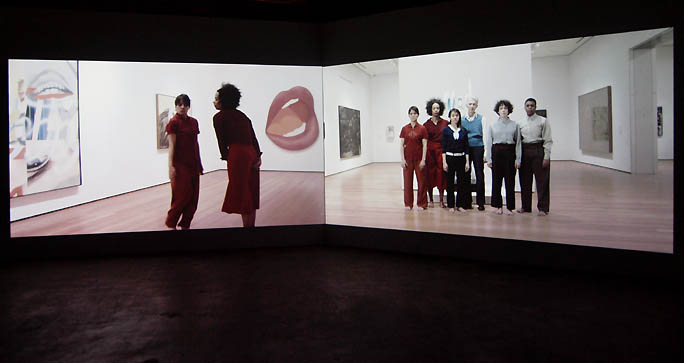 Three Chants Modern at PICA by Andrea Geyer (photos Jeff Jahn) Creation myths are revealing fabrications and contemporary art in America has one. Perhaps the most telling element of which can be summoned through asking the simple question, who started MoMA? … that crucial institution of the Twentieth Century, which both championed and contextualized modern and contemporary art? If queried many would say, “Alfred Barr Jr.” (MoMA's first director and architect of that first contextual framework) or Nelson Rockefeller (who put up the money) but it was his mother Abby and her compatriots Lillie P. Bliss and Mary Sullivan who conceived and chartered the idea, bringing everyone to the table. MoMA acknowledges this fact openly but without context it remains remote and abstracted in the minds of visitors and the world at large when they discuss the museum. Where is the context? For example, a place like the Abby Aldrich Rockefeller Sculpture Garden... perhaps the most interesting viewing space at the museum doesn't really convey the energy and networking the dynamic trio collectively brought to the enterprise. Instead, its architectural vernacular is one of a separated island... remote and separate from the galleries. It is something the much hated new expansion designed by DS+R could have addressed but does not. Instead, it turns the garden island into an overcrowded full time free space opened to the street and sacrificed to the goal of visitor traffic flow management. When it comes to museum spaces, things given away freely rarely command the same solemn value or regard as that which demands something of the viewer. Apparently, the new MoMA has forgotten Abby or treats her merely as a hostess at the door? In fact, all of New York city's major museums were started by women. Thus, it is more than ironic that the interconnected context of the story of these three women is rarely discussed, despite the fact that their affinities were the ones with the drive and interest in the subject matter of new art, which defined the institution's inception. Sure, a PHD project and a book on the subject would shed some light here and there is already a book on the collection but it would be difficult to recapture their voices and the excitement such an enterprise must have held. 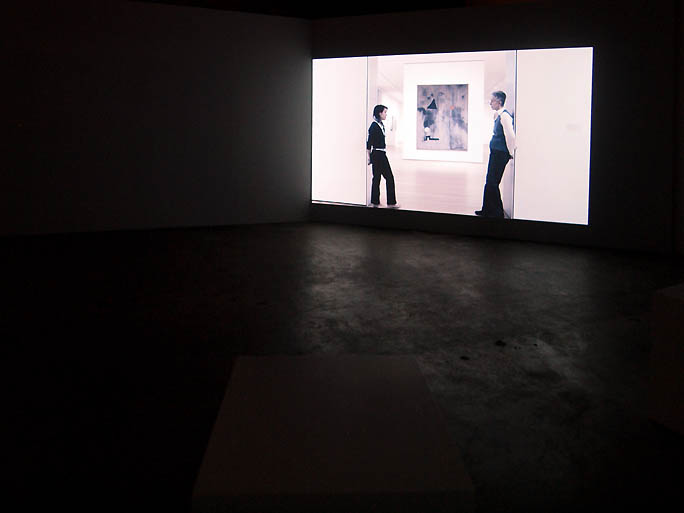
In that absence, enter Andrea Geyer, whose research based art on display in Three Chants Modern at PICA is as much a seance that reconvenes the spirit of women at MoMA as it is a re-sequencing of the visitor's experience of the museum. Lucky for Portland, PICA is presenting the US premier of the work which consists of a photograph, an installation and a dual channel video. It is an important exhibition and it brings the current crisis at MoMA (perhaps the defining one of the institution) into sharp relief. MoMA isn't/shouldn't be about moving visitors... it is about being a caretaker and promoter of moving ideas. It is about keeping those ideas alive and continually present. Those ideas/ideals began in small groups of people comitted to them. 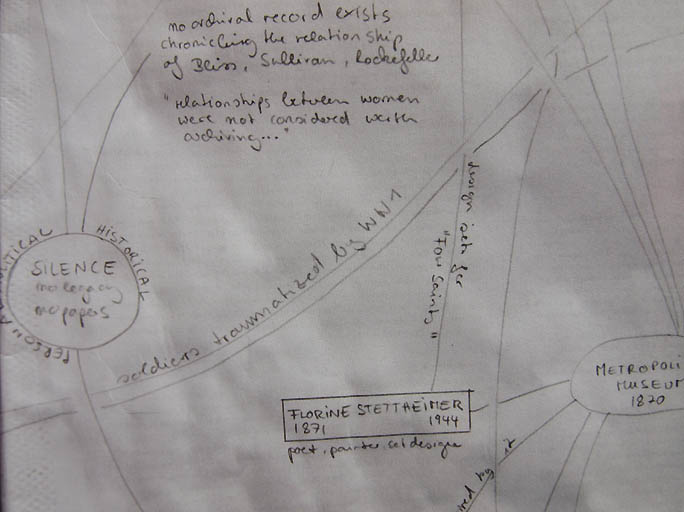
Three Chants Modern handout cover (detail) What's more, Geyer's show goes far beyond Abby, Lillie and Mary's legacy, instead fitting them into the present as a crucial web of activists, contacts, patrons, practitioners, friends, lovers and colleagues who defined cultural life in the United States during the Twentieth Century. Disparate names like; Helen Clay Frick, Lee Miller, Lyubov Popova, Betty Parsons, Adele Levy, Ellen Gates Starr and Alice Trumbull Manson all figure in a vast web of influences and affinities in her gallery handout, which serves as background for the Three Chants Modern video piece, the culmination of Geyer's 2013 Research Residency at MOMA. Just paging through the handout is eye opening alone as a kind of pamphleteer. Looking at the handout for Andrea Geyer's Three Chants Modern show at PICA, the cover alone strikes me, with its diagram mapping the association with Abby, Lilly and Mary and the the fact that none of their correspondences were preserved in the Museum's archive stating that, “relationships between women were not considered important enough to archive,” and thus “no papers” detailing such constitute a historical silence with “no legacy.” It is significant but left just at the handout the show would become a lament in absence. Geyer goes much further and the rigor never lets up. 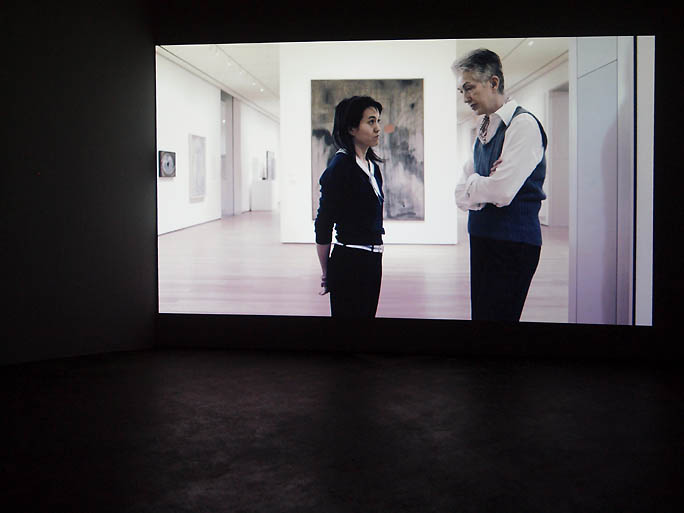
Going beyond the handout, what Geyer has done with her Three Chants Modern video is make that absence, physically and emotionally palpable with an overlay of improvised dance and modified protest chants (as a kind of proxy institution within an institution). It would have been easy for Geyer to simply rely on the obvious historical cover up to make art that is simply “relevant”... contemporary art's shorthand for topical work rather than “Great Work”. But she goes much farther by being relentlessly present. She does this by daring to connect the viewers on multiple shifting emotional, canonical and kinesthetic levels as a simultaneously seamless and yet difficult to categorize and layered experience as both a dance and a museum tour. This has roots in Hellen Keller's (an anti fascist campaigner) introduction to modern dance by none other than Martha Graham. You can see the video here and the odd kinesthetic guide aspect informs the choreography in Geyer's piece. To further contextualize Three Chants Modern, think of dance being used as a form of archeological exploration within MoMA's galleries. It is no accident that it works and a lot of care was taken as frankly, on paper the idea of dancing and singing in front of the art at MoMA presents a minefield of “too easy” opportunities. Somehow as a gestalt, the precision and candor of the chants, dances and camera work in Geyer's piece elevates this project above a moral inevitability and into the realm of artistic imperative that breaks new ground. Thankfully it doesn't go backwards and instead by taking itself so very seriously in the present it avoids getting bogged down in second guessing... There is grace and it creates space in the viewer's institutional tour rather than suffocate with moral proscriptions. This is key as most of us know culture is created in a process that is far from fair. We also know that everything that comes around goes around and 2014 is the year women in visual arts have the mic. That said, this is the piece everyone should see as it simultaneously displays MoMA's prescience and intentional blindness towards women without diminishing either aspect. Three Chants Modern consists of two screens and follows 3 separate pairs of women (in blue, red and green respectively) who dance and convene in front of major works of art like Les Demoiselles d'Avignon and Cezanne's The Bather. These are two of the most seminal works in the collection and both were donated or funded acquisitions by Lilly Bliss. In fact, every work featured prominently either depicts women or was donated by a woman. By choosing such famous works, Geyer's dancers (who all convene together to perform the chant moments) create a parallel universe that exists simultaneously with the timeless works, thereby calling the activities of women and their relationship to the works into reflection. 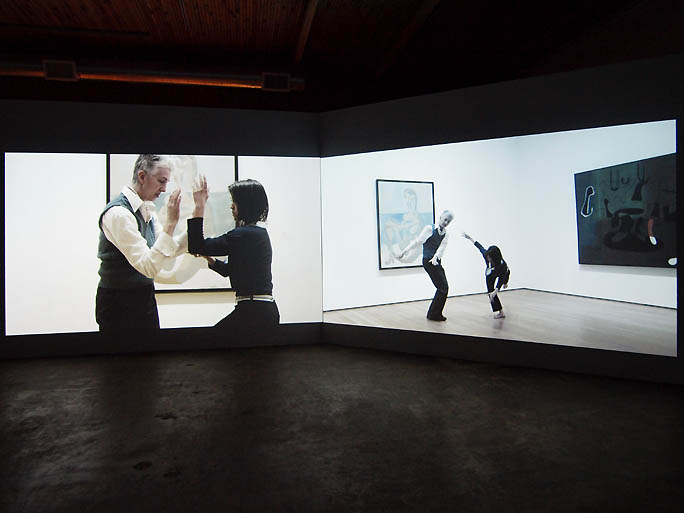
At certain points the pairs of dancers make eye contact with the camera, which brings the viewer into the discussion. Each pair has a different dynamic. For example the blue pair, consisting of a taller grey haired woman and a young asian woman seem to be having a historical discussion. Their dance fittingly begins in front of Joan Miro's The Birth of the World. When their eyes meet ours the painting is in full view (historically it is seen as a precedent for abstract expressionism and the very macho New York School). Eventually the blue duo end up in front of Picasso's Bathers, donated by Mrs. Simon Guggenheim (nee Olga Hirsch) which is a curious painting where a child or metaphorical self doubts seem to buffet the woman about the head. It is one of those images that riffs off of Picasso's dual reputation for misogyny and or loving playfulness. The duo's dance heightens the existential duality and ambiguity. The same happens when all three groups are chanting in front of Matisse's La Danse (1909). The lyrics seem to say, let's not dance anonymously, let's say our peace here and now... while having this experience of artistic greatness. Its this revelation and obstruction that makes this tour of MoMA so interesting and separates it from a film like Russian Ark which is more of a period spectacle or Eve Sussman's 89 seconds at Alcazar which is also a historical recreation. Instead, this tour is a very present tense. 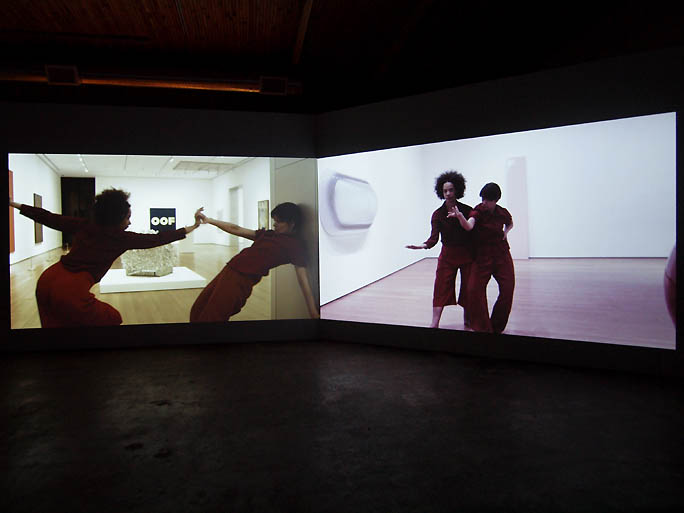
The next group revealed, a red duo, consisting of one caucasian and one black woman are closer in age and seem more romantically engaged than the blue duo. Their dance is far more physical as they move in front of Jo Baer's austere canvases or behind De Wain Valentine’s large Triple Disk Red Metal Flake — Black Edge (1966) sculpture. Overall, things are kinkier and more physical with a few great what are you looking at moments... where one of the dancers catch the viewer's gaze as they bend and stretch in front of the Tom Wesselman Mouth 7, depicting a woman's large lips. I also love the way these dancers are used to reveal Ed Ruscha's OOF in the background. Pop art's acceptance came with a Mad Men style cost, with women's bodies becoming an advertisement. 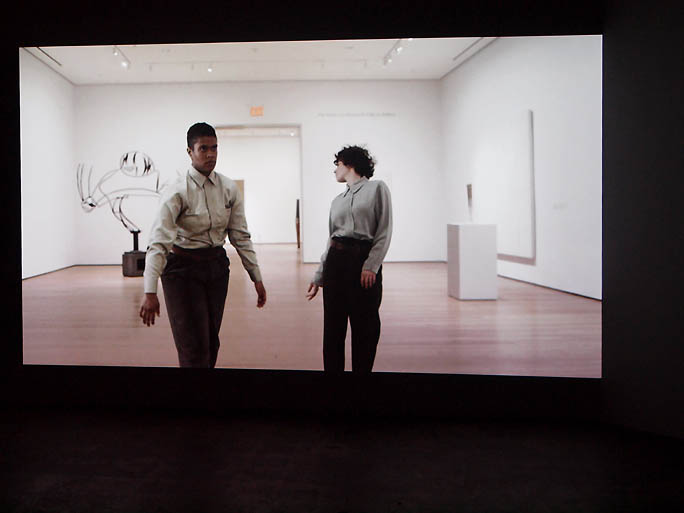
My favorite duo, consisting of a Miranda July-ish haired dancer and a trans man have the most idiomatic moves. Sometimes moving in alternate directions, at others in tandem... they seem to be at work as much as play. I love it when one is looking into receding space and the other is looking forward but both are tethered but some unseen force... At several times the 3 separate groups convene in front of works like Louise Bourgeois' Quarantania, which fittingly depicts Bourgeois' friends and family as she left Europe or Les Demoiselles d'Avignon and chant. Here is an excerpt of the words: I step into a moment of greatness loud thoughts and quiet voice words roll into this open air as newly loosened noise breath presence in our freed up space refreshed by modern minds a vision brave and scrupulous emotions lost their binds. A breeze of new social orders no space for hang over frights A pathfinders dream of visions Now moves us to unseen heights Good bye all your self-sublimation strong pull of will on the streets Its in these halls of culture where revolutionary labor meet. A wave of pure emotion running through the air Hands touch greatness soft and bare My pulse records their beat of soul She feels herself whole, she feels herself whole. Eventually all three pairs go off simultaneously hand in hand and look at major works, re-emphasizing both the loss and the shared enjoyment of the human experience. The video element is supported by seating, which are gallery plinths. A nice touch and as one leaves there is an armada of crates for artworks and a photo still from the video, both of which remind us of the way our memories package that which we have just seen. By addressing greatness so directly in a time when so much art is about a middling academic formula Geyer reinvigorates the conversation. She implicates women in the enterprise of greatness that was MoMA's mission and asks why so much of their contribution remains hidden? This is all incredibly topical because it is still going on. MoMA, with their new expansion seems to be losing that which Abby, Lilly and Mary instilled as a storehouse and champion of great ideas. Also, with the art worlds massive expansion in the Twenty First Century and relative largess at the collector and top institutional level a serious problem has been foregrounded. According to a recent study 70% of the artists represented in galleries are men, and it is no secret that work by female artists routinely goes for less than their male counterparts at auction. The thing is, where MoMA goes everyone else follows. The institution did a great thing in commissioning Geyer's Three Chants Modern via a research residency but it reminds the of their great strengths... a collection that can change the way we see the world. Why their new expansion doesn't feel like Three Chants Modern shows just how important Geyer's work is right now. I strongly suggest that everyone who cares about art (and is fortunate enough to afford a ticket) get on a plane and visit PICA now as Three Chants Modern is a masterpiece in kinesthetic historical revisionist empathy. True, many other artists have presented research as art but most only succeed in creating a small utopian community that starts and ends with its own context... Three Chants Modern is something far more powerful, pragmatic and historically percussive over the long haul. Three Chants Modern | Andrea Geyer On view through June 21, 2014 PICA | 415 SW 10th Posted by Jeff Jahn on April 30, 2014 at 16:41 | Comments (0) Comments Post a comment Thanks for signing in, . Now you can comment. (sign out)
(If you haven't left a comment here before, you may need to be approved by
the site owner before your comment will appear. Until then, it won't appear
on the entry. Thanks for waiting.)
|
| s p o n s o r s |
 |
 |
 |
 |
 |
 |
 |
 |
 |
 |
 |
 |
 |
 |
 |
 |

|
Site Design: Jennifer Armbrust | • | Site Development: Philippe Blanc & Katherine Bovee | |

